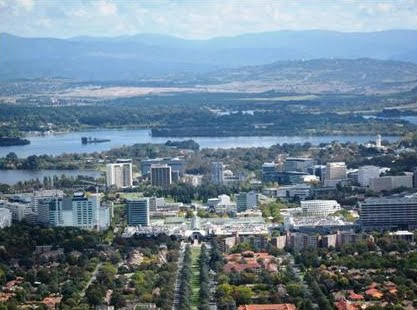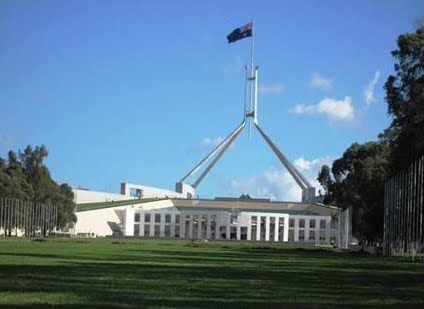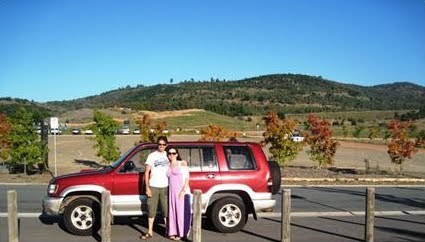I can see those folks in Canberra, the Australian capital, smirking, maybe even laughing. Another dork, this time a mindless Scot, the host on The Late, Late Show is merely the latest idiot to give their city a serve. And secretly, I am sure, Canberrans are pleased, for like the guardians of Shangri-la, they are not at all keen to have everyone know just how good their city is, lest more want to come there and settle! So while epithets like ‘soulless,’ ‘sterile’ and ‘too planned,’ roll off the tongues of mere peepers and unappreciative visitors, simply spend the time to really look around, and I am sure you will leave wishing you were staying, because in so many ways, Canberra has ‘got it all.’
I had not been to Canberra for nearly a decade, and for me it was akin to a youth returning as an adult, an adult returning as a grand-parent. Venerable inner suburbs, many still showing their British-design roots and foliage, were now full of alterations, tempering the old with modern, angular designs, large windows and skylights to draw in the winter sun, for unlike many Australian cities, Canberra does experience all the seasons. In the outer areas, whole new suburbs had been introduced, infrastructure provided, and houses built before releasing the next parcels of land, so that development was uniform and not gap-toothed. Each group of suburbs with parks and amenities, schools, shops, interlinked bike paths and ornamental lakes for leisure or pleasure, separated from each other by stands of bush. Canberra doesn’t do messy, and visible poverty is simply banished! Yes, Canberra was not only growing up, but out, to accommodate its 360,000 dwellers, no longer the purely ‘government town’ I had once known, now with admirable light and service industries, retail outlets and commerce.

Canberra looking over the War Memorial to Parliament House
While the city celebrates its centenary of the beginning of its construction next year, its incorporation as a city dates from 1928, so in the array of world capitals, it really is still a relatively new kid on the block. Plans were drawn up following an international competition which was won by the Chicago architect, Walter Burley Griffin and his wife Marion, and incorporated settlement in a series of geometric designs, separated by native vegetation, much like a giant design of ‘flower beds.’ And while it is not a city of historic or aged beauty like London, Paris or Rome, its beauty actually lies in the way that it has been planned as a most livable place, with an abundance of commanding sights, buildings and amenities, a mountain backdrop, and always in touch with the surrounding bush which curls through it. No wonder it is called ‘The Bush Capital.’
Canberra, like Washington or Brasilia, has its own federal skirt of territory, and as development has been closely controlled through covenants and ordinances, for all land is leased from the Government, the ridgelines have been kept free from development. Looking from one of the many hilly vantage points, height restrictions have meant that taller buildings only dominate in particularly designated areas, while suburbia simply melds with the bush. Only the buildings and the introduced ‘foreign’ trees, which in spring and autumn add a marvelous touch of colour to the blue-grey of the eucalyptus cover, show where man has settled.

The city centre, the Western lake and the Brindabella mountains beyond
In 2003, Canberra paid a terrible price for ‘living with the bush,’ when bushfires destroyed or damaged 70% of the Australian Capital Territory’s bush, pine plantations, and grazing land. Five hundred homes were destroyed and four people were killed. Lessons were learned, but work to rebuild damaged areas and start new ones, began immediately. Where once a vast pine forest stood, now an arboretum featuring stands of trees from a host of countries, sweeps over the low hills, so ensuring that Canberra’s bald patches will soon be gone again. Even in adversity, there has been beautification. The air is clean again and wildlife, hosts of incredibly coloured parrots, sonorous magpies and curawongs, are at home in the suburbs, while kangaroos patrol the ridges and cause a flutter in the hearts of golfing foreigners, as they hop around many of Canberra’s golf courses. It is a place where nature rewards itself with caroling trills and the winnowing of the wind.
Canberra’s Lake Burley Griffin, is its centerpiece. The languid Molonglo river flows through a former dairy flat, with fields as though imported from Ireland, and past the beautifully appointed Royal Military College, Duntroon before it broadens into the East Basin, its banks patrolled by weeping willow trees. The central basin is symmetrically dissected by two low slung bridges, forming the Parliamentary triangle with the modern Parliament House, one of the world’s great buildings of the Twentieth century, and its symbolic flagpole, at the apex. Within the triangle stand some of the city’s major buildings, the High Court, the National Gallery, the National Portrait Gallery, the Old Parliament House, the Science museum and the National library, the defence and security establishments, and the Australian War Memorial, all often floating ethereally on summer lake reflections, or on a bed of winter fog.

Lake Burley Griffin looking East past the bike track and Carillion
Wags used to say that everything in Canberra went in circles, and not just the politicians, whose presence arguably has fostered the ‘’ blame Canberra’ mentality. When things are going poorly for the Government, there is a tendency to ‘blame Canberra” in the same manner that Washington, Ottawa and Brussels often get unfairly roasted, merely because it is the place of the seat of government! Most of Canberra’s tree lined streets have some measure of curve and there is little of the gridded suburbia that one sees elsewhere. Furthermore, there are no front fences in Canberra, although many have grown discrete hedges, but generally your view carries an invitation all the way to the front door, generally over manicured lawns or garden beds. When we arrived in Canberra in the 1970s, the Government nursery provided each resident with four trees and twenty shrubs to encourage garden pride, but now the prevalence of many nurseries shows that inducement is no longer necessary. And in the perfectly placed parks, there are always kids ‘mucking about with balls,’ depending on the season whether cricket or football. Given that Australians are a highly litigious mob, all the kiddie play parks have now been made as safe as possible to prevent injury. Alas, not any more the thrill of flying foxes, Maypoles and Jungle Jims, where a bruise or graze was proud evidence of risk-taking!
It is at the nurseries, on a weekend, that you see people out for the big late breakfast, but then again, Canberra is a foodie haven as much of the rest of Australia, with its great coffee culture, round the clock eateries, and an abundance of fresh produce ‘farmers markets.’ The price of food has gone up considerably since my last stay, but then the overall quality had probably improved too. Sure, there is still the good old Aussie pie but it is now so much richer in filling, and in exotic Asian varieties as well!

New Parliament House, opened in Australia’s Bi-centennial year, 1988
Canberra too has encouraged foreign embassies to build their chanceries in the architectural style of their country, and the result is a spectacular array of buildings seen nowhere else in Australia, Thai, Japanese, Greek, Indian, American-colonial, a Papua New Guinea long house, to name but a few, all manicured and on display for locals and visitors alike. Then too, in an exercise of democratic rights, there is the constant vigil at the Aboriginal ‘tent’ Embassy, right across the road from the Old Parliament House, and has been the scene of struggles with authorities wanting to pull it down. As the nation’s capital, political protests, marches and gatherings are commonplace in the parliamentary precinct and are regarded by most Australians as a key part of their democratic rights. Then again, most marches are noisy but peaceful, with a general respect for the police as well as personal and public property.
Canberra really has got it all, great vistas, public land available to all for recreation, open spaces, and hidden riverside picnic spots in the countryside less than half an hour from the centre of the city. It has a rich arts structure, great galleries and museums, wonderful festivals such as the Floriade massed-bulb festival on the banks of Lake Burley Griffin each Spring, superb sporting and educational venues, the most modern health facilities, unsurpassed infrastructure, low crime rates, and a lifestyle which is the envy of many. Government itself is highly decentralized and most workers live within thirty minutes of their offices. It is three hour’s easy drive from the glitz of Sydney, ninety minutes from the pristine South coast with its surf and seclude beaches, and the same distance from the winter snowfields in the Australian Alps. It has the most modern airport facility in Australia, first class hotels and shopping, and a healthy and invigorating climate. It is both large enough, and small enough, to show you a good time and meet every need, in a modern setting which acknowledges the past and preserves the old. It is the host for ‘blockbuster art’ from Rembrandt to Pollock, and wild enough to host the annual Summernats of souped up street cars.

A mob of kangaroos on the ridgeline above suburbia
Maybe it is envy that drives detractors, or maybe it’s just their innate shallowness in not appreciating that something can be as well planned as Canberra, and still offer so much fun and lifestyle joy. So next time someone tells you Canberra is dull and un-engaging, just nod sagely, for the people of Canberra will thank you for it. They know what a great place it is, for it’s a secret they happily harbor, and as you know, secrets are not always for sharing!

Contented Canberrans at the superb road and off-road cycling facility
Winfred Peppinck is the Tales of the Traveling Editor for Wandering Educators
All photos courtesy and copyright Winfred Peppinck
